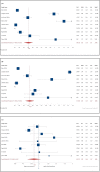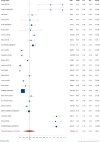Estimating the prevalence of heterozygous familial hypercholesterolaemia: a systematic review and meta-analysis
- PMID: 28864697
- PMCID: PMC5588988
- DOI: 10.1136/bmjopen-2017-016461
Estimating the prevalence of heterozygous familial hypercholesterolaemia: a systematic review and meta-analysis
Abstract
Objectives: Heterozygous familial hypercholesterolaemia (FH) confers a significant risk for premature cardiovascular disease (CVD). However, the estimated prevalence of FH varies substantially among studies. We aimed to provide a summary estimate of FH prevalence in the general population and assess variations in frequency across different sociodemographic characteristics.
Setting, participants and outcome measures: We searched MEDLINE, EMBASE, Global Health, the Cochrane Library, PsycINFO and PubMed for peer-reviewed literature using validated strategies. Results were limited to studies published in English between January 1990 and January 2017. Studies were eligible if they determined FH prevalence using clinical criteria or DNA-based analyses. We determined a pooled point prevalence of FH in adults and children and assessed the variation of the pooled frequency by age, sex, geographical location, diagnostic method, study quality and year of publication. Estimates were pooled using random-effects meta-analysis. Differences by study-level characteristics were investigated through subgroups, meta-regression and sensitivity analyses.
Results: The pooled prevalence of FH from 19 studies including 2 458 456 unique individuals was 0.40% (95% CI 0.29% to 0.52%) which corresponds to a frequency of 1 in 250 individuals. FH prevalence was found to vary by age and geographical location but not by any other covariates. Results were consistent in sensitivity analyses.
Conclusions: Our systematic review suggests that FH is a common disorder, affecting 1 in 250 individuals. These findings underscore the need for early detection and management to decrease CVD risk.
Keywords: familial hypercholesterolemia; frequency; meta-analysis; prevalence; systematic review.
© Article author(s) (or their employer(s) unless otherwise stated in the text of the article) 2017. All rights reserved. No commercial use is permitted unless otherwise expressly granted.
Conflict of interest statement
Competing interests: None declared.
Figures





References
-
- Slack J. Inheritance of familial hypercholesterolemia. Atheroscler Rev 1979;5:35–66.
Publication types
MeSH terms
LinkOut - more resources
Full Text Sources
Other Literature Sources
Medical
Miscellaneous
